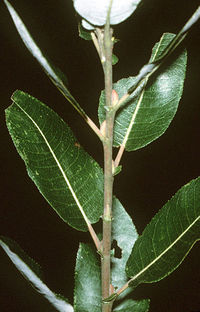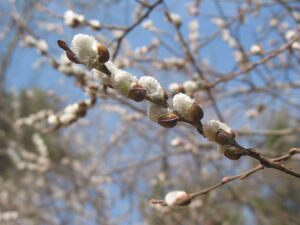Salix discolor: Difference between revisions
No edit summary |
No edit summary |
||
| (3 intermediate revisions by 2 users not shown) | |||
| Line 1: | Line 1: | ||
{{SPlantbox | |||
|familia=Salicaceae | |||
|genus=Salix | |||
|species=discolor | |||
|taxo_author=Muhl. | |||
|common_name=Pussy Willow, American Pussy Willow, American Willow | |||
|name_ref=Flora - A Gardener's Encyclopedia | |||
|habit=tree | |||
|habit_ref=Flora - A Gardener's Encyclopedia | |||
|Max ht box=25 | |||
|Max ht metric=ft | |||
|height_ref=Flora - A Gardener's Encyclopedia | |||
|Max wd box=15 | |||
|Max wd metric=ft | |||
|width_ref=Flora - A Gardener's Encyclopedia | |||
|lifespan=perennial | |||
|life_ref=Flora - A Gardener's Encyclopedia | |||
|exposure=sun | |||
|sun_ref=Flora - A Gardener's Encyclopedia | |||
|water=wet, moist | |||
|water_ref=Sunset National Garden Book | |||
|features=deciduous, flowers | |||
|flower_season=early spring, mid spring, late spring, early winter, mid winter, late winter | |||
|flower_ref=Flora - A Gardener's Encyclopedia | |||
|Temp Metric=°F | |||
|min_zone=2 | |||
|usda_ref=Flora - A Gardener's Encyclopedia | |||
|max_zone=9 | |||
|sunset_zones=1-24, 30-45 | |||
|image=Salix discolor (USDA).jpg | |||
|image_width=200 | |||
|image_caption=Shoot with leaves | |||
}} | |||
'''''Salix discolor''''' ('''American Willow'''<ref name=grin>Germplasm Resources Information Network: [http://www.ars-grin.gov/cgi-bin/npgs/html/taxon.pl?102704 ''Salix discolor'']</ref>) is a species of [[willow]] native to [[North America]], one of two species commonly called [[Pussy Willow]]. | |||
[[Image:pussy willow branch.jpg|thumb|left|Branch with catkins in early spring]] | |||
It is native to the northern forests and wetlands of [[Canada]] ([[British Columbia]] east to [[Newfoundland and Labrador|Newfoundland]]) and the northeastern contiguous [[United States]] ([[Idaho]] south to [[Wyoming]], and east to [[Maine]] and [[Maryland]]).<ref name=grin/><ref name=bc>Plants of British Columbia: [http://linnet.geog.ubc.ca/Atlas/Atlas.aspx?sciname=Salix+discolor ''Salix discolor'']</ref><ref name=boreal>Borealforests: [http://www.borealforest.org/shrubs/shrub44.htm ''Salix discolor'']</ref> | |||
It is a weak-wooded [[deciduous]] [[shrub]] or small [[tree]] growing to 6 m tall, with brown shoots. The [[leaf|leaves]] are oval, 3–14 cm long and 1-3.5 cm broad, green above and downy grey-white beneath. | |||
The [[flower]]s are soft silky silvery [[catkin]]s, borne in early spring before the new leaves appear, with the male and female catkins on different plants ([[plant sexuality|dioecious]]); the male catkins mature yellow at [[pollen]] release. | |||
The [[fruit]] is a small [[capsule (fruit)|capsule]] 7–12 mm long containing numerous minute seeds embedded in cottony down.<ref name=bc/><ref name=boreal/> | |||
As with the closely related ''[[Salix caprea]]'' (European Pussy Willow), it is also often grown for cut flowers. See [[Pussy Willow]] for further cultural information and other uses. | |||
{{Inc| | {{Inc| | ||
Salix discolor | '''''[[Salix]] discolor'''''. Pussy Willow. A shrub or short-trunked tree, 10-20 ft. high: buds very large and nearly black: lvs. smooth and bright green above, whitish beneath, irregularly crenate-serrate: aments appear early in spring, before the lvs., closely sessile, enveloped in long, silky hairs. E. N. Amer.—Worthy of more extended cult. and thriving in dry ground. | ||
}} | }} | ||
==Cultivation== | |||
===Propagation=== | |||
===Pests and diseases=== | |||
==Varieties== | |||
=== | ==Gallery== | ||
<gallery perrow=5> | |||
Image:Upload.png| photo 1 | |||
Image:Upload.png| photo 2 | |||
Image:Upload.png| photo 3 | |||
</gallery> | |||
==References== | ==References== | ||
< | <references/> | ||
*[[Standard Cyclopedia of Horticulture]], by L. H. Bailey, MacMillan Co., 1963 | |||
<!--- xxxxx *Flora: The Gardener's Bible, by Sean Hogan. Global Book Publishing, 2003. ISBN 0881925381 --> | |||
<!--- xxxxx *American Horticultural Society: A-Z Encyclopedia of Garden Plants, by Christopher Brickell, Judith D. Zuk. 1996. ISBN 0789419432 --> | |||
<!--- xxxxx *Sunset National Garden Book. Sunset Books, Inc., 1997. ISBN 0376038608 --> | |||
==External links== | |||
*{{wplink}} | |||
{{ | {{stub}} | ||
__NOTOC__ | |||
Latest revision as of 17:13, 18 August 2010
| Salix discolor subsp. var. | Pussy Willow, American Pussy Willow, American Willow | |||||||||||||||||||||||||||||||||||||||||||||||||||||||
|---|---|---|---|---|---|---|---|---|---|---|---|---|---|---|---|---|---|---|---|---|---|---|---|---|---|---|---|---|---|---|---|---|---|---|---|---|---|---|---|---|---|---|---|---|---|---|---|---|---|---|---|---|---|---|---|---|

|
|
| ||||||||||||||||||||||||||||||||||||||||||||||||||||||
| ||||||||||||||||||||||||||||||||||||||||||||||||||||||||
Salix discolor (American Willow[1]) is a species of willow native to North America, one of two species commonly called Pussy Willow.

It is native to the northern forests and wetlands of Canada (British Columbia east to Newfoundland) and the northeastern contiguous United States (Idaho south to Wyoming, and east to Maine and Maryland).[1][2][3]
It is a weak-wooded deciduous shrub or small tree growing to 6 m tall, with brown shoots. The leaves are oval, 3–14 cm long and 1-3.5 cm broad, green above and downy grey-white beneath.
The flowers are soft silky silvery catkins, borne in early spring before the new leaves appear, with the male and female catkins on different plants (dioecious); the male catkins mature yellow at pollen release.
The fruit is a small capsule 7–12 mm long containing numerous minute seeds embedded in cottony down.[2][3]
As with the closely related Salix caprea (European Pussy Willow), it is also often grown for cut flowers. See Pussy Willow for further cultural information and other uses.
| Standard Cyclopedia of Horticulture |
|---|
|
Salix discolor. Pussy Willow. A shrub or short-trunked tree, 10-20 ft. high: buds very large and nearly black: lvs. smooth and bright green above, whitish beneath, irregularly crenate-serrate: aments appear early in spring, before the lvs., closely sessile, enveloped in long, silky hairs. E. N. Amer.—Worthy of more extended cult. and thriving in dry ground.
|
Cultivation
Propagation
Pests and diseases
Varieties
Gallery
-
photo 1
-
photo 2
-
photo 3
References
- ↑ 1.0 1.1 Germplasm Resources Information Network: Salix discolor
- ↑ 2.0 2.1 Plants of British Columbia: Salix discolor
- ↑ 3.0 3.1 Borealforests: Salix discolor
- Standard Cyclopedia of Horticulture, by L. H. Bailey, MacMillan Co., 1963
External links
- w:Salix discolor. Some of the material on this page may be from Wikipedia, under the Creative Commons license.
- Salix discolor QR Code (Size 50, 100, 200, 500)
